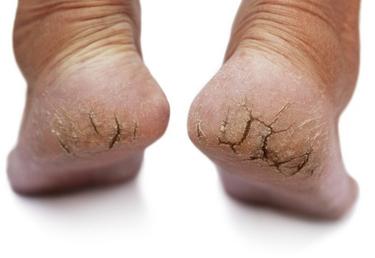Cracked heels, also known as heel fissures, are a common, uncomfortable, unsightly, and sometimes painful foot condition. They are characterized by large crevices surrounded by thick, dry cracked and dead skin, that vary in depth around the perimeter of one or both heels, often resulting in heel pain and discomfort.
Heel fissures may develop so deep that it is possible to see small amounts of blood seeping from them, giving them a dark red or black appearance. Once they have reached this point, there is an increased chance that the foot becomes infected, so treatment is necessary.

If you have diabetes or another condition that reduces blood flow to your feet, you’re at greater risk of complications resulting from dry cracked heels and feet.
Cause
Cracked heels develop when the skin’s moisture and vitamin levels are inadequate, especially when the heels are subjected to prolonged periods of standing. Skin dehydration is more commonly seen in elderly patients, who consume less water, and in those with poor circulation, such as smokers.
When someone puts weight on their heels, the skin naturally expands to help absorb the impact. However, when the skin is dehydrated, it cannot expand, unless it tears apart, leading to the development of heel fissures and dry cracked feet.
Symptoms
Symptoms of heel fissures include:
- Cracks of varying depth along the perimeter of one or both heels
- Thick, rough, dry and scaling skin around your heels
- A localized stinging pain around your
Treatment
If caught early enough, heel fissures can be treated by applying a recommended foot cream 3 to 4 times a day while making subtle life style changes such as increasing your water and vitamin intake, or quitting smoking. However, if left untreated, the condition can quickly worsen, and you may require your Chiropodist or Podiatrist (Foot Specialist) assistance in resolving the condition.
Most people who have heel fissures resolve them by:
- Trimming away excess skin: Your Chiropodist may pare down the heel fissures to expose the healthy skin. Do not attempt this yourself as it can lead to infection.
- Callus-removing medication: You may be prescribed a keratolytic compound to aid in the removal of the dead skin.
- Emollients: A foot cream containing at least 10-20% urea may be recommended to prevent recurrence of the fissures.
- Occlusion: In severe cases, you may be provided with occlusive devices, such as bed time heel socks, to increase the penetration of the emollient. These are typically worn for 5 to 7 days at night, with favorable results.
- Heel files: Once reduced by your Chiropodist, you may want to gently file your heels once a week with a clean heel file to prevent the build up of new dead skin. This is usually done following a bath or shower.
- Retinoid therapy: If you have a diffused case of thick, rough and dry skin that affects the whole sole of the foot, and commonly your hands too, you may require topical retinoid cream to resolve your condition. This therapy promotes healthy skin turnover, an may yield positive results.
Contact us today to see how we can help resolve your dry and cracked heels.

